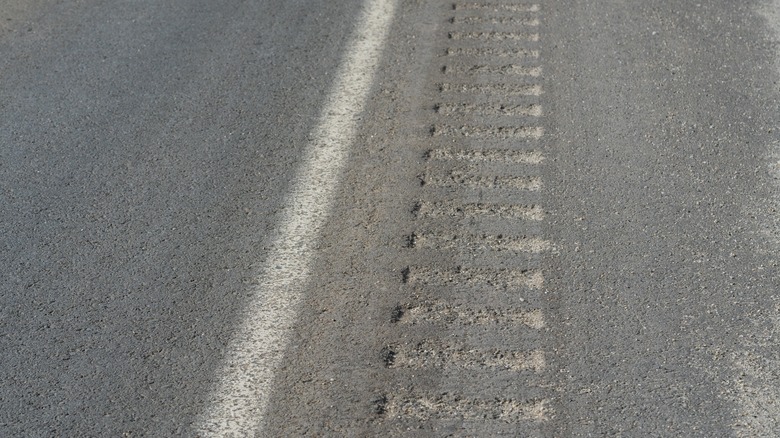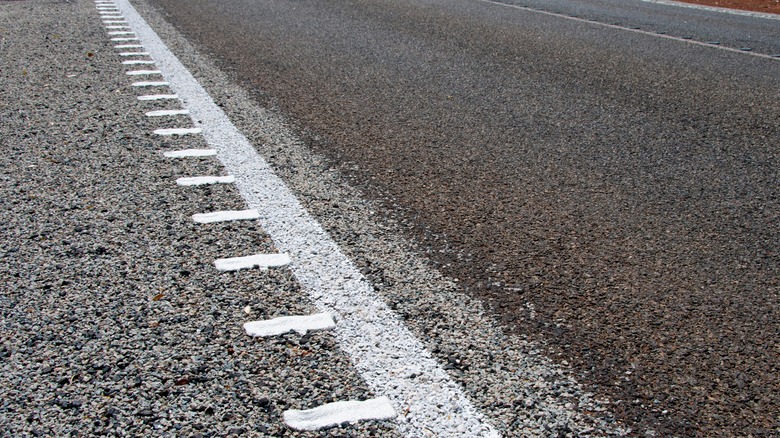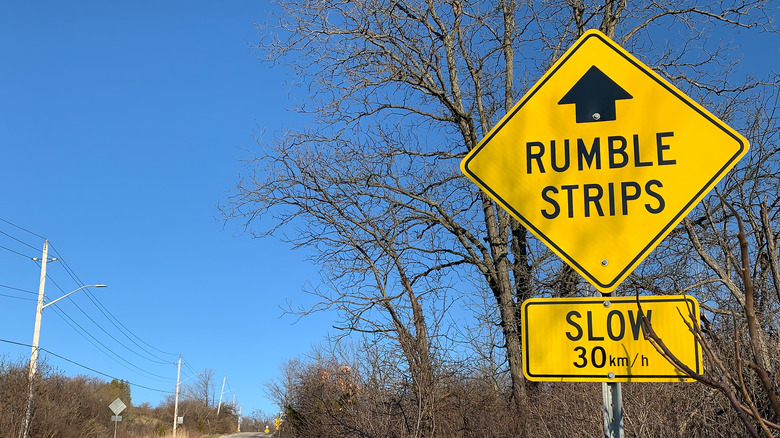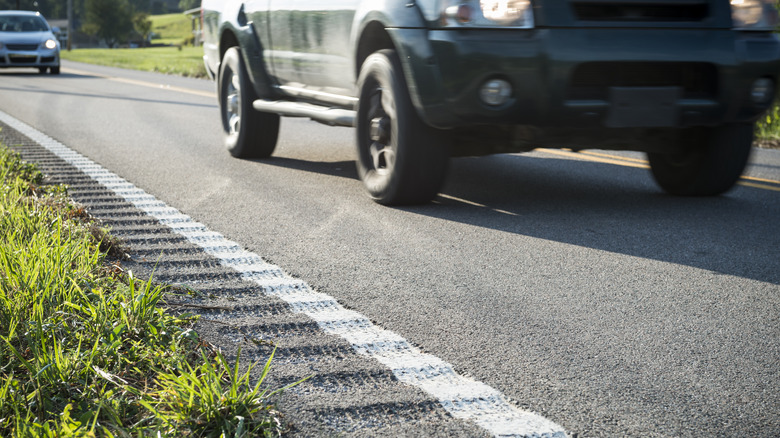Rumble Strips: What's The Purpose Of The Grooves Etched Into The Side Of The Road?
Here's a scenario you've probably encountered at least once: you're driving along the highway, doing your best to stay in your own lane, when suddenly, beneath your notice, you drift ever so slightly out of the lines. Suddenly, you hear a distinct grinding sound coming from beneath your car, accompanied by an unpleasant vibrating sensation. Startled, you grip the wheel and course-correct, and sure enough, the sound and vibration disappear. Have you just been visited by some kind of highway gremlin? No, you've just had a run-in with a rumble strip.
Rumble strips are special stretches of modified pavement present on many roads around the United States, especially along the nation's highways. These strips are specially placed in a way to gently discourage the occasional sleepy motorist from drifting out of their lanes and into another motorist's path. It's an ingeniously simple solution for what would otherwise be a pretty big problem, but considering how startling an experience encountering a rumble strip can be, it's fair to worry if it might be damaging your car in some way. The good news is that you have nothing to fear from rumble strips, provided you're driving your car the way you're supposed to be.
Rumble strips are large grooves or bumps placed on the sides of certain roads
As you drive along the many highways of the United States, you probably aren't paying much mind to the particulars of the road beyond what's right in front of you. If you ever happen to be stopped along the highway or sitting in the passenger's seat, though, take a good look at the sides of the road. You may notice that the pavement is either raised or milled in a distinctive, long-stretching pattern. That's not a stylistic choice for those browsing highways on Google Maps, those are rumble strips.
Rumble strips can be placed in the center of a two-way highway or on the far shoulder, sometimes both. In many cases, rumble strips may be overlaid with the lane stripes in these areas, which creates what's known as a rumble stripe. Rumble strips and stripes are most often found on large two-way highways with at least two lanes of travel in both directions. Whether you encounter rumble strips on a particular stretch of highway or freeway depends on where you live; some states employ them, while others don't.
The jarring vibration produced by rumble strips is meant to keep you alert
The entire purpose of rumble strips, as indicated by their name, is to produce their distinctive vibrating rumble when a car drives over them. If it sounds unpleasant, that's because it's supposed to. Rumble strips are placed on the centers and shoulders of a highway to serve as a sort of analog warning alarm to distracted drivers. If you hear the unpleasant sound and feel the rumble coming through your seat, you know you've drifted out of your lane and need to course correct immediately. Since the rumble is so jarring, it has the added effect of alerting drivers who may be nodding off.
If you're tired or otherwise distracted on the road, it's possible for your grip on the steering wheel to slack a bit, which can lead to the car listing in one direction or the other. Highway driving is a very delicate dance, and if one car leaves a lane when its driver doesn't intend to, it can put them and other motorists in danger of collisions, doubly so if you're listing into traffic coming the other way. Rumble strips may seem like an overly simple solution to this problem compared to something like built-in lane assist systems, but based on studies, they're actually quite effective. According to research from the National Cooperative Highway Research Program, the presence of rumble strips reduces the occurrence of severe car crashes by up to 50% on rural two-lane roads and up to 91% on urban two-lane roads.
Rumble strips will only damage your car if you regularly drive over them at high speed
Whenever you run over something on the highway that's large enough that it can be felt through your seat, your first worry is probably going to be whether or not your car has been damaged somehow. Even if you know what rumble strips are and what they're there for, it can be hard to shake that instinctive worry that something has gone wrong. The good news is that, much like how occasionally hitting a bump too hard or running over a large rock won't significantly damage your car, an occasional brush with a rumble strip is nothing to worry about. So long as your car is in good condition in general, a brief bump on the shoulder of the road won't hurt your tires or transmission.
It is worth noting, however, that if you were to continuously drive on rumble strips for miles at a time, especially at high speed, then your car may start to receive some damage. In fairness, this isn't really the rumble strips' fault. When you feel a rumble strip, you're supposed to course-correct and drive off of it, so if you just keep on driving, it's only natural you're going to get some unnecessary wear and tear on your wheels and suspension.



